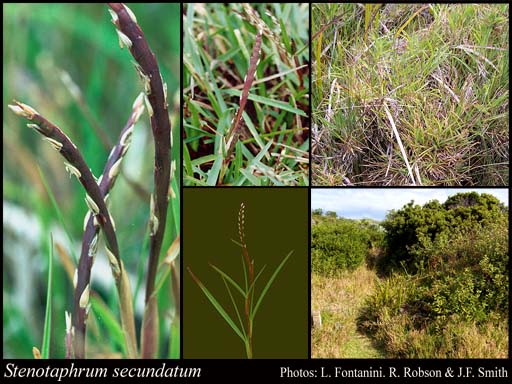- Reference
- Revis.Gen.Pl. 2:794 (1891)
- Conservation Code
- Not threatened
- Naturalised Status
- Alien to Western Australia
- Name Status
- Current
Stoloniferous, decumbent perennial (forming large colonies), grass-like or herb, (0.05-)0.1-0.5 m high. Fl. green-purple, Sep to Dec or Jan to Apr. Grey or black peaty sand. Cultivated as a lawn, has become naturalized, lake edges, estuaries.

Distribution
- IBRA Regions
- Esperance Plains, Jarrah Forest, Swan Coastal Plain, Warren.
- IBRA Subregions
- Dandaragan Plateau, Fitzgerald, Northern Jarrah Forest, Perth, Recherche, Southern Jarrah Forest, Warren.
- IMCRA Regions
- Central West Coast, Leeuwin-Naturaliste, WA South Coast.
- Local Government Areas (LGAs)
- Albany, Armadale, Augusta Margaret River, Busselton, Cambridge, Cockburn, Dardanup, Denmark, Esperance, Gingin, Harvey, Manjimup, Mundaring, Murray, Nedlands, Rockingham, South Perth, Stirling.
Management Notes (for the Swan NRM Region)
Alternative Names. St. Augustine grass.
General Biology. Growth form. Grass. Life form. Perennial, stoloniferous. Reproduction. Stolons, occasionally seed. Dispersal. Water, plantings (lawn), occasionally livestock (seed in dung), machinery,shoes, dumped vegetation/soil, soil movement. Photosynthetic Pathway. C4. Toxicity. Produces allergens in summer. Implicated in calcinosis in cattle. Fire response. Resprouts.
Notes. Widely naturalised. Because of its dense growth and long-lived mat habit it can readily smother other species. Tolerant of a wide range of climatic conditions. Extremely shade tolerant, grows on poor soils, salt and drought tolerant, intolerant of heavy frost. Extremely tolerant of defoliation and survives under low fertility. Although commonly found on siliceous and calcareous sands, it can grow on a wide range of well or poorly drained soils, from sandy loams to light clays. Diploid types are more tolerant of cold and frost than many tropical grasses. Triploid types have poor cool season growth. Considerable variation in flowering time and intensity and frost tolerances exists among cultivars.
Additional information. Origin. Africa, North and South America. History of use/introduction. Pasture, silage, erosion control, lawn/turf, seed contaminant.
Suggested method of management and control. Spray with 1% glyphosate 2-3 times over a single growing season, alternatively spray Fusilade® Forte 13ml/L + wetting agent or for generic fluazifop-p (212g/L active ingredient) 8ml/L. Solarisation over warmer months can be useful for small, isolated infestations. Read the manufacturers' labels and material safety data sheets before using herbicides. For further information consult the Australian Pesticides and Veterinary Medicines Authority to determine the status of permits for your situation or state.
Management Calendar
| Calendar Type | Jan | Feb | Mar | Apr | May | Jun | Jul | Aug | Sep | Oct | Nov | Dec | Comments |
|---|---|---|---|---|---|---|---|---|---|---|---|---|---|
| Active Growth | Y | Y | Y | Y | Y | O | O | O | O | Y | Y | Y | |
| Flowering | Y | Y | O | O | Y | ||||||||
| Optimum Treatment | Y | Y | Y | Y | Y | Y | Y |
Legend: Y = Yes, regularly, O = Occasionally, U = Uncertain, referred by others but not confirmed.
References
- Anon. (2010) Detailed information sheet: Stenotaphrum secundatum. Weedbusters, Hamilton, New Zealand. URL: http://weedbusters.co.nz/weed_info/detail.asp?WeedID=109 - Accessed January 2010.
- Brown, K. & Brooks, K. (2002) Bushland Weeds: A Practical Guide to their Management. Environmental Weeds Action Network, Greenwood.
- Cook, B.G., Pengelly, B.C., Brown, S.D., Donnelly, J.L., Eagles, D.A., Franco, M.A., Hanson, J., Mullen, B.F., Partridge, I.J., Peters, M. & Schultze-Kraft, R. (2005) Tropical Forages: an interactive selection tool - Stenotaphrum secundatum. CSIRO, DPI&F (Qld), CIAT and ILRI, Brisbane, Australia. URL: http://www.tropicalforages.info/key/Forages/Media/Html/Stenotaphrum_secundatum.htm - Accessed January 2010.
- Hussey, B.M.J., Keighery, G.J., Dodd, J., Lloyd, S.G. & Cousens, R.D. (2007) Western Weeds. A guide to the weeds of Western Australia. 2nd Edition. The Plant Protection Society of Western Australia, Victoria Park.
- Moore, C.B. & Moore, J.H. (2002) Herbiguide, the pesticide expert on a disk. Herbiguide, PO Box 44 Albany, Western Australia, 6330.
- Moore, J.H. & Wheeler, J. (2008) Southern weeds and their control. DAFWA Bulletin 4744.
- Mullen, B.F. & Shelton, H.M. (1996) Stenotaphrum secundatum: A valuable forage species for shaded environments. Tropical Grasslands, 30 (3): 289-297.
- Muyt, A. (2001) Bush invaders of South-East Australia: A guide to the identification and control of environmental weeds found in South-East Australia. R.G. & F.J. Richardson, Melbourne.
- Prescott, R.A. & Potter, P.C. (2001) Allergenicity and cross-reactivity of Buffalo Grass (Stenotaphrum secundatum). South Africa Medical Journal, 91: 237-243.
- USDA, ARS, National Genetic Resources Program (2009) Germplasm Resources Information Network - (GRIN). National Germplasm Resources Laboratory, Beltsville, Maryland. URL: https://npgsweb.ars-grin.gov/gringlobal/taxon/taxonomysimple.aspx - Accessed October 2009.